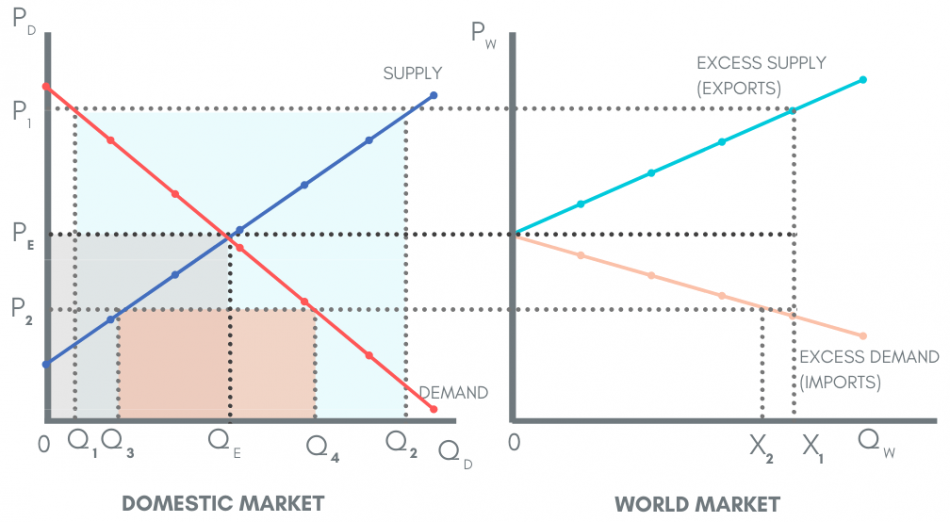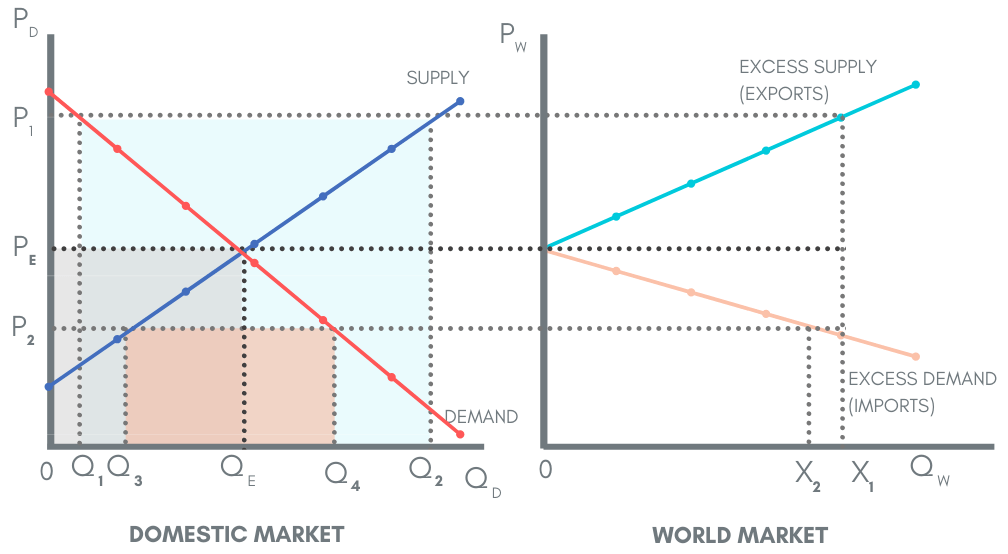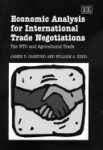In times of uncertainty, we need to be certain about barrier-free trade
 What is happening in the world? I am not talking about the pandemic, I am asking, what is happening in the world that we see importers placing trade embargos on international firms (i.e. China and CDN canola), restricting ‘safe’ products from being imported, or denying the science of the exporter. This is possible thanks to a nation’s right to invoke international trade law and legislation. While the rejection of trade is not new and has included products rejected by importers, bans imposed on chemicals and products, and even trade restrictions on an entire firm’s business. As an agricultural exporting nation, trade laws and regulations protect us, but at times can be a hindrance.
What is happening in the world? I am not talking about the pandemic, I am asking, what is happening in the world that we see importers placing trade embargos on international firms (i.e. China and CDN canola), restricting ‘safe’ products from being imported, or denying the science of the exporter. This is possible thanks to a nation’s right to invoke international trade law and legislation. While the rejection of trade is not new and has included products rejected by importers, bans imposed on chemicals and products, and even trade restrictions on an entire firm’s business. As an agricultural exporting nation, trade laws and regulations protect us, but at times can be a hindrance.
Now that we are faced with uncertainties created by COVID-19, maintaining a balance of trade and trade relations has become that much more important to our economy.
Limited yet open
While trade at times can feel like it’s more a hindrance, we first should consider how it works and why, before we judge it, as it’s not a simple process. Trade is vital to all of Canadian agriculture, whether it’s producers, industry, or consumers. Producers profit from selling excess supply abroad, the industry benefits from being able to act as an intermediary of products across borders, and consumers can enjoy global products as if they were locally produced. I highly doubt many would think we would benefit if we got rid of trade, but the question is, is the current trade system working in our best interests?
It is! It may not be perfect, but the current international trade regulation is working in our favour for the most part. The reason being that we are an exporting nation who need trade to create balances. Like in life, in trade there are advantages to doing one thing well, rather than many things just alright. Trade allows us to specialize and profit, while importing goods or services to balance out the specialized basket we have in trade. We clearly observe this in the agricultural world of food production.
Without getting too into the balance of trade, economies of scale, or even specialization, international trade allows us to meet demand with supply. Western Canada produces excess amounts of grains, oilseeds and pulses, and relies on the export market (producing more than QE). This export demand allows the agriculture industry to carry on producing at the scale they do and remain profitable. Without open trading, producers would either need to reduce their production to meet domestic market demands (QE), sell their product at a much lower price (selling at PE or even P2 instead of P1), or switch to another commodity to produce. By having access to the world market, we can continue to produce what we produce well while filling the global demands.

Looking at the graphs above, if we assume we produce only what we need in the domestic market and do not trade (autarky), price and quantity will be in equilibrium at QE and PE. In the world market, if we produced exactly what we needed domestically, our world trade will be 0 at PE. Now let assume the world price P1 is greater than our domestic price of PE for a commodity like wheat. At this new price, our domestic demand decreases due to the high price, while production increases and we export this excess supply from of Q1 to Q2 (exporting to X1) at this profitable world price. However, when the world price drops, say to P2, suddenly our domestic demand goes up, yet our supply will be low, therefore, we turn to the world market to import from Q3 to Q4.
For consumers of a developed nation, we want to keep to trade open, as it grants us access to a plethora of goods at lower prices then we could produce domestically. Open trade has given us access to items that cannot be produced in Canada, from exotic spices to staples like bananas, chocolate and coffee. Open trade allows consumers access to these products or ingredients that either cannot be produced locally or cannot be produced at a low enough price. I would hate to imagine during our self-quarantine losing access to inexpensive coffee, or the number of imported ingredient we are relying on right now, which offers diversity in our recipes. I don’t want to imagine what this COVID-19 self-isolation would look like if suddenly coffee and chocolate was no longer available, it might not be on your essential list, but sure is on mine, right behind toilet paper!
While not a set of agricultural commodities, many of our nations are relying on the trade of essential health care products. This included trade or masks, gloves, ventilators, pharmaceuticals, and medical-grade chemicals for many of our essential drugs. Without trade, many of our nations would be worse off, as these are specialized products, which are often imported from nations like China, who can produce for a much lower cost and more efficiently.
Open trade regulations
We have open trade thanks to trade agreements. The World Trade Organization (WTO) includes 164 countries that are connected through relatively open agreements, which are designed to help keep an even playing field. Here are the basics about the WTO.
- The WTO is voluntary and has been operational since 1995.
- The organization and its members agree upon a set of accepted rules.
- Not every nation and every industry can be winners. The WTO is based on compromises, there will be agreements made in which one industry or nation may be a winner/benefit, while the other losses. In the WTO, there is no Win-Win-Win solution.
- Under the WTO, there are three established agreements:
- “The goal [of the WTO] is to help producers of goods and services, exporters, and importers conduct their business”, with the intent to open trade. Trade has increased as a result of removing several trade tariffs and barriers formerly put in place to protect their national goods and services.
- The WTO has been beneficial in many ways to its members:
- Costs are cut– Tariffs are used to protect domestic producers and when tariffs are imposed, they increase the cost of goods and services. Therefore, the WTO’s reduction of market barriers, such as tariffs, decreases prices for consumers. From 1995-2000, the agreements to the Uruguay Round of WTO cut agricultural tariffs and subsidies for developed countries by 36% and 24% reduction for developing countries.
- Nations can specialize and stimulate economic growth– Members of the WTO open up their domestic market to 163 other international markets. This market access offers the opportunity in reaching new clients, sourcing inputs and technologies, and pushing efficiencies.
- Good governance – while a nation wants to protect its interests; this doesn’t necessarily represent greater interests. The WTO puts pressure on those seeking protectionism, as well as “help reduce corruption and bad government.”
- The WTO has a Dispute Settlement Mechanism in place to resolve any trade disputes between countries and any trade violations. The dispute process is implemented to avoid trade retaliation and sanctions. The loophole of the dispute process is that the WTO is not a legal entity or a governing body, and therefore the judgement of the dispute cannot be enforced if the accused is found guilty of breaking the agreement.
- The WTO is the base/floor for all other agreements or annexes amongst member nations. This means, nations within the WTO can form trade agreements with other WTO members, but all agreements are subject to the WTO’s latest agreement. An agreement cannot retract from previously made WTO agreements. For instance, if Canada and the US have x units of free trade on wheat under the WTO, any new trade agreements on wheat must be greater than x, not less, for wheat. On March 13, 2020, the USMCA was ratified, a trade agreement is made on top of current WTO agreements amongst, Canada, Mexico and the US.
[su_button url=”https://www.wto.org/english/thewto_e/whatis_e/10thi_e/10thi00_e.htm” target=”blank” style=”soft” background=”#2b9f77″ size=”7″ center=”yes” radius=”round” icon=”https://215.0eb.myftpupload.com/wp-content/uploads/2020/03/WTO-logo-C3AE4A3D71-seeklogo.com_.png” icon_color=”#ffffff” text_shadow=”1px 1px 0px #000000″]Click to read more about what WTO can do…[/su_button]
More trade to come
With all of the good that comes from being an open trading nation under the WTO, there are times when it seems like the structure in place is only letting us down. Currently, we are experiencing numerous changes in our politics, environment, and now global health, in which the balance and comradery of trade are vital. As a nation that is known for its reliable and safe agricultural production and one that relies on trade, we must understand the world-trading playing field going forward.




